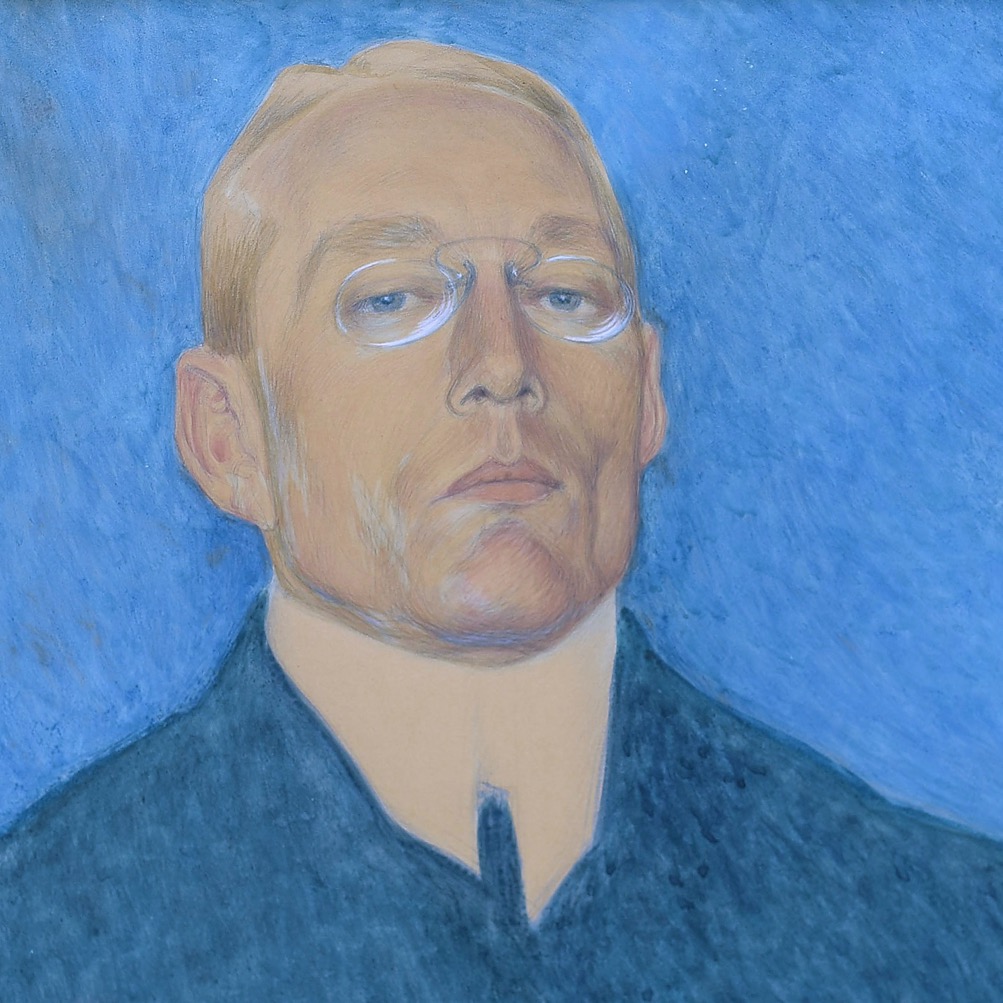An Icon Has Found Home
Valdemar Andersen's portrait of author and Nobel Laureate Johannes V. Jensen has found its home as a museum piece.
The portrait has been known as a photo in black and white and heavily cropped. The painting itself has barely been seen in public since it was painted. Still, Valdemar Andersen's portrait of Johannes V. Jensen has had the status of an icon. Now it has been acquired by the Johannes V. Jensen and Thit Jensen Museum in Farsø - colloquially the Jensen Museum - for a completely new life.
 |
| Valdemar Andersen, Johannes V. Jensen, 1905. From 2024 at the Jensen Museum. Photo: Niels C.B. Larsen. |
The portrait was created during Valdemar's busiest years as a cartoonist. He belonged to the new crop of artists just after 1900 that made their presence known everywhere in public life. There were posters to be made, not to mention newspapers and a constant flow of new magazines in which their works could be widely and immediately disseminated, and Valdemar Andersen was known for his running through Copenhagen with rolls of paper tucked under his arms from one editor to the next. He was even drawn in a newspaper advertisement with said rolls of paper portrayed as a personality around town. It was crucial was to be seen and preferably everywhere so that new opportunities could arise from them.
He was not yet a cartoonist for the daily Politiken in 1905 since these were the early years of his career. His model was at the same stage in his course of establishing his name as a writer. They were both well underway, but their major works were still lying ahead. In 1905, Johannes V. Jensen had before him to publish poems with the intention of revolutionising a new era into being, becoming a newspaper publisher inspired from travels in the US, and declaring his own take on the evolution of the world.
So, of course, Valdemar Andersen brazenly postulated his model to be an author at the pinnacle of fame.
It is not an easy task to portray writers through their profession. They tend to be shown with pens and books, writing or reading in professional contemplation. To do so they are looking into their own world while turned away from the beholder. Valdemar Andersen chose to cut out everything. There is nothing to symbolise Johannes V. Jensen's profession other than being the mastermind confronting us the inferior beings, who are his beholders. He looks down at us with his head thrown slightly back so that we are fully aware that we are not the ones winning the confrontation.
The composition is as subtle as it is intricate. His head is placed to the left of the vertical central axis of the picture plane, while his hands are folded to the right, giving the illusion of a head and mind beyond reach. Then again, the shoulder to the left too should be the furthest from us. Instead everything on the right side is exaggerated out of proportion from the shirt flip to that right hand. Nothing is at rest. Everything on the surface is in tension.
Valdemar Andersen declared himself an artist, but he did not work in a traditional art form, so there was every reason to prove his position by debuting the portrait at the censored spring exhibition at Charlottenborg in 1906. His co-exhibitors cultivated medieval tales or imitated the grandeur of the early renaissance and preferably in colossal formats that the press coverage devoured with delight and made the noise that everyone had to see that year. A few years later Valdemar Andersen teasingly drew the noisiest of the 1906-exhibition, Oscar Matthiesen, who exhibited seven meters of dragoons in the nude.
For his own portrait, however, Valdemar had found his role model in Lucas Cranach the Elder.
_-_Portra%CC%88t_des_Martin_Luther_(Deutsches_Historisches_Museum).jpg) |
| Lucas Cranach the Elder (Workshop), Martin Luther, 1259. Photo: Deutsches Historisches Museum. |
 |
| Valdemar Andersen, detail of Johannes V. Jensen, 1905. From 2024 at the Jensen Museum. Photo: Niels C.B. Larsen. |
 |
| Valdemar Andersen, The evolution according to Johannes V. Jensen, printed in Plat'Menagen, 1909. Photo: Niels C.B. Larsen. |
Valdemar Andersen was to draw cartoons of Johannes V. Jensen a number of times for the latter's public persona. We see how close model and portraitist both were to establishing their name in 1905 from the fact that in 1909 Valdemar drew Johannes V. Jensen as the culmination of his own writings. Johannes V. Jensen as an ape is the beginning and the perfection of evolution in the very same figure. This time a single tool is included, because Johannes V. Jensen had described the invention of fire in his novels and he could now light his cigar. His cheeks are still furrowed and the head is as always thrown back. He never stooped to the level of us, his beholders.
The painted portrait of Johannes V. Jensen has been owned by the same family for 95 years and has been well looked after. It is in mint condition as if newly painted. Johannes V. Jensen never owned it himself. From now on, it is to be seen in his own museum.


